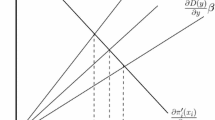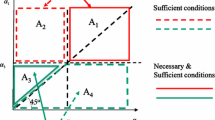Abstract
We consider the design of ambient taxes forrisk-neutral and risk-averse polluters whenpolluters and the regulatory agency haveasymmetric information about environmentalrelationships and probabilities associatedwith random events. Unlike prior work, we showthat under these conditions, optimal ambienttaxes must be firm-specific, and accompaniedby additional incentives to influencepolluters' choices of abatement techniques.
Similar content being viewed by others
References
Bar-Shira, Z. (1992), ‘Nonparametric Test of the Expected Utility Hypothesis’, American Journal of Agricultural Economics 74, 523–533.
Bostrom, A. (1997), ‘Vaccine Risk Communications: Lessons from Risk Perception, Decision Making and Environmental Risk Communication Research’, Risk: Health, Safety & Environment 8, 959–970.
Braden, J. B. and K. Segerson (1993), ‘Information Problems in the Design of Nonpoint Source Pollution Policy’, in C.S. Russell and J.F. Shogren, eds., Theory, Modeling and Experience in the Management of Nonpoint - Source Pollution. Boston: Kluwer Academic Publishers.
Cabe, R. and J. Herriges (1992), ‘The Regulation of Nonpoint-Source Pollution Under Imperfect and Asymmetric Information’, Journal of Environmental Economics and Management 22, 134–146.
Duda, A.M. (1993), ‘Addressing Nonpoint Sources ofWater PollutionMust Become an International Priority’, Water Science and Technology 28, 3–5.
Fisher, A. (1991), ‘Risk Communication Challenges’, Risk Analysis 11, 173–179.
Hanley, N., J. F. Shogren, and B. White (1997), Environmental Economics: In Theory and Practice. New York: Oxford.
Hansen, L. G. (1998), ‘A Damage Based Tax Mechanism for Regulation of Non-Point Emissions,’ Environmental and Resource Economics 12, 99–112.
Herriges, J. R., R. Govindasamy and J. Shogren (1994), ‘Budget-Balancing Incentive Mechanisms’, Journal of Environmental Economics and Management 27, 275–285.
Horan, R. D., J. S. Shortle and D. G. Abler (1998), ‘Ambient Taxes when Polluters Have Multiple Choices’, Journal of Environmental Economics and Management 36, 186–199.
Machina, M. J. (1987), ‘Choice Under Uncertainty: Problems Solved and Unsolved’, Economic Perspectives 1, 121–154.
Miceli, T. J. and K. Segerson (1991), ‘Joint Liability in Torts: Marginal and Infra-Marginal Efficiency’, International Review of Law and Economics 11, 235–249.
National Research Council (1993), Soil and Water Quality. Washington, D.C.: National Academy Press.
Segerson, K. (1988), ‘Uncertainty and Incentives for Nonpoint Pollution Control’, Journal of Environmental Economics and Management 15, 88–98.
Shortle J. S. and D. G. Abler (1997), ‘Nonpoint Pollution’, in H. Folmer and T. Teitenberg, eds., International Yearbook of Environmental and Natural Resource Economics: Cheltenham, UK: Edward Elgar.
Shortle, J. S. and D. G. Abler (1994), ‘Incentives for Nonpoint Pollution Control’, in C. Dosi and T. Tomasi, eds., Nonpoint Source Pollution Regulation: Issues and Analysis. Dordrecht: Kluwer Academic Publishers.
Shortle, J. S. and J.W. Dunn (1986), ‘The Relative Efficiency of Agricultural SourceWater Pollution Control Policies’, American Journal of Agricultural Economics 68, 668–677.
Slovic, P. (1987), ‘Perception of Risk’, Science 236, 280–285.
Tomasi, T., K. Segerson and J. Braden (1994), ‘Issues in the Design of Incentive Schemes for Nonpoint Source Pollution Control’, in T. Tomasi and C. Dosi, eds., Nonpoint Source Pollution Regulation: Issues and Policy Analysis. Dordrecht: Kluwer Academic Publishers.
U.S. Environmental Protection Agency (1992), Managing Nonpoint Pollution: Final Report to Congress on Section 319 of the Clean Water Act, EPA-506/9-90.
World Resources Institute (1988), World Resources 1988-1989: An Assessment of the Resource Base that Supports the Global Economy. Washington, D.C.: World Resources Institute.
Xepapadeas, A. (1994), ‘Controlling Environmental Externalities: Observability and Optimal Policy Rules’, in T. Tomasi and C. Dosi, eds., Nonpoint Source Pollution Regulation: Issues and Policy Analysis. Dordrecht: Kluwer Academic Publishers.
Xepapadeas, A. (1992), ‘Environmental Policy Design and Dynamic Nonpoint Source Pollution’, Journal of Environmental Economics Management 23, 22–39.
Xepapadeas, A. (1991), ‘Environmental Policy Under Imperfect Information: Incentives and Moral Hazard’, Journal of Environmental Economics Management 20, 113–126.
Author information
Authors and Affiliations
Rights and permissions
About this article
Cite this article
Horan, R.D., Shortle, J.S. & Abler, D.G. Ambient Taxes Under m-Dimensional Choice Sets, Heterogeneous Expectations, and Risk-Aversion. Environmental and Resource Economics 21, 189–202 (2002). https://doi.org/10.1023/A:1014584418846
Issue Date:
DOI: https://doi.org/10.1023/A:1014584418846




